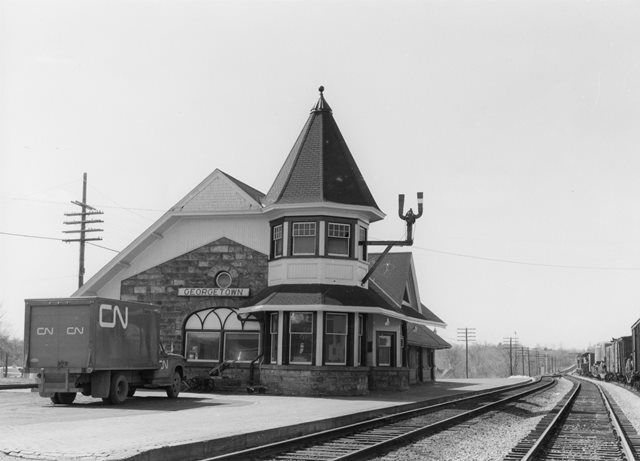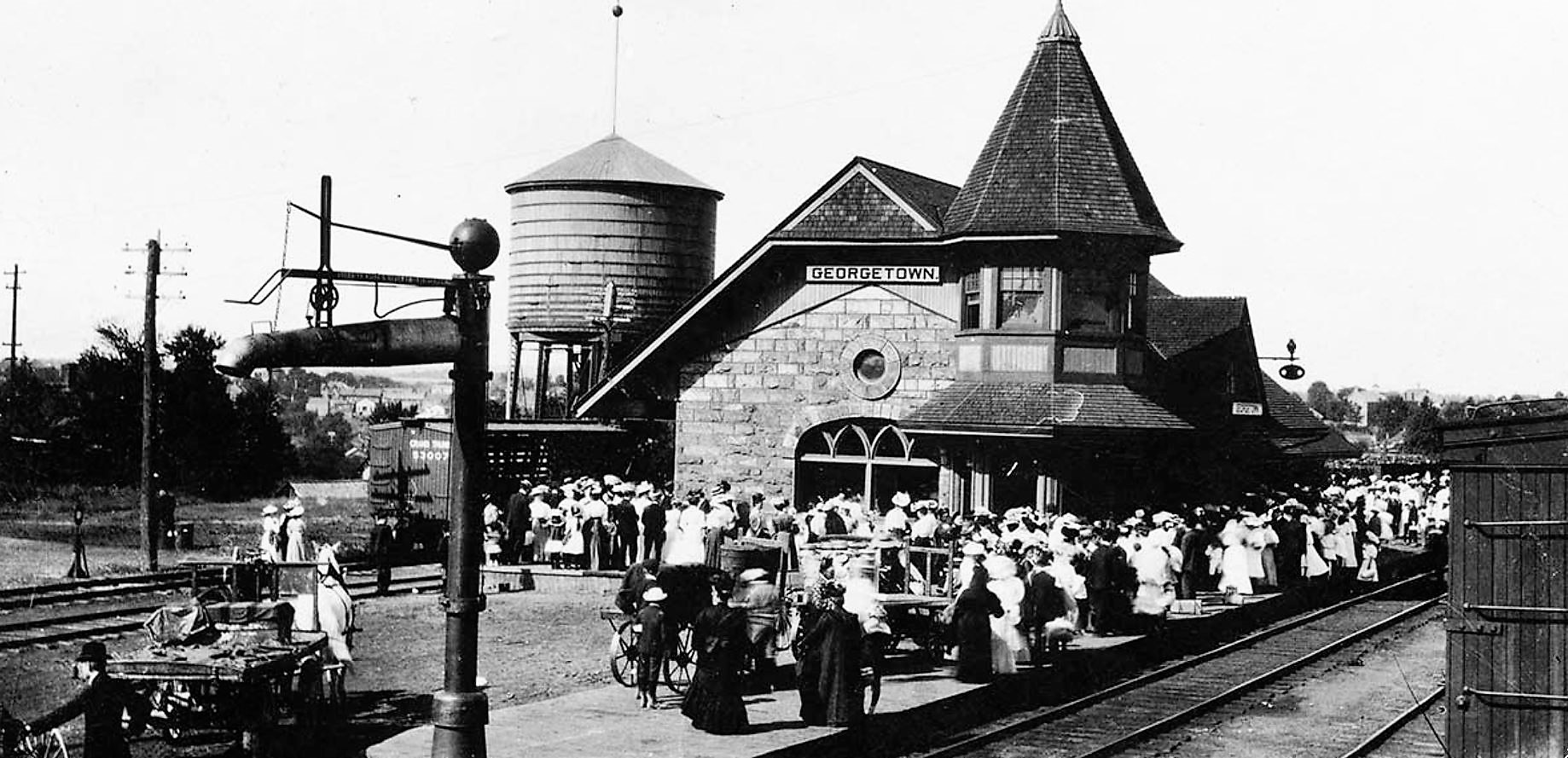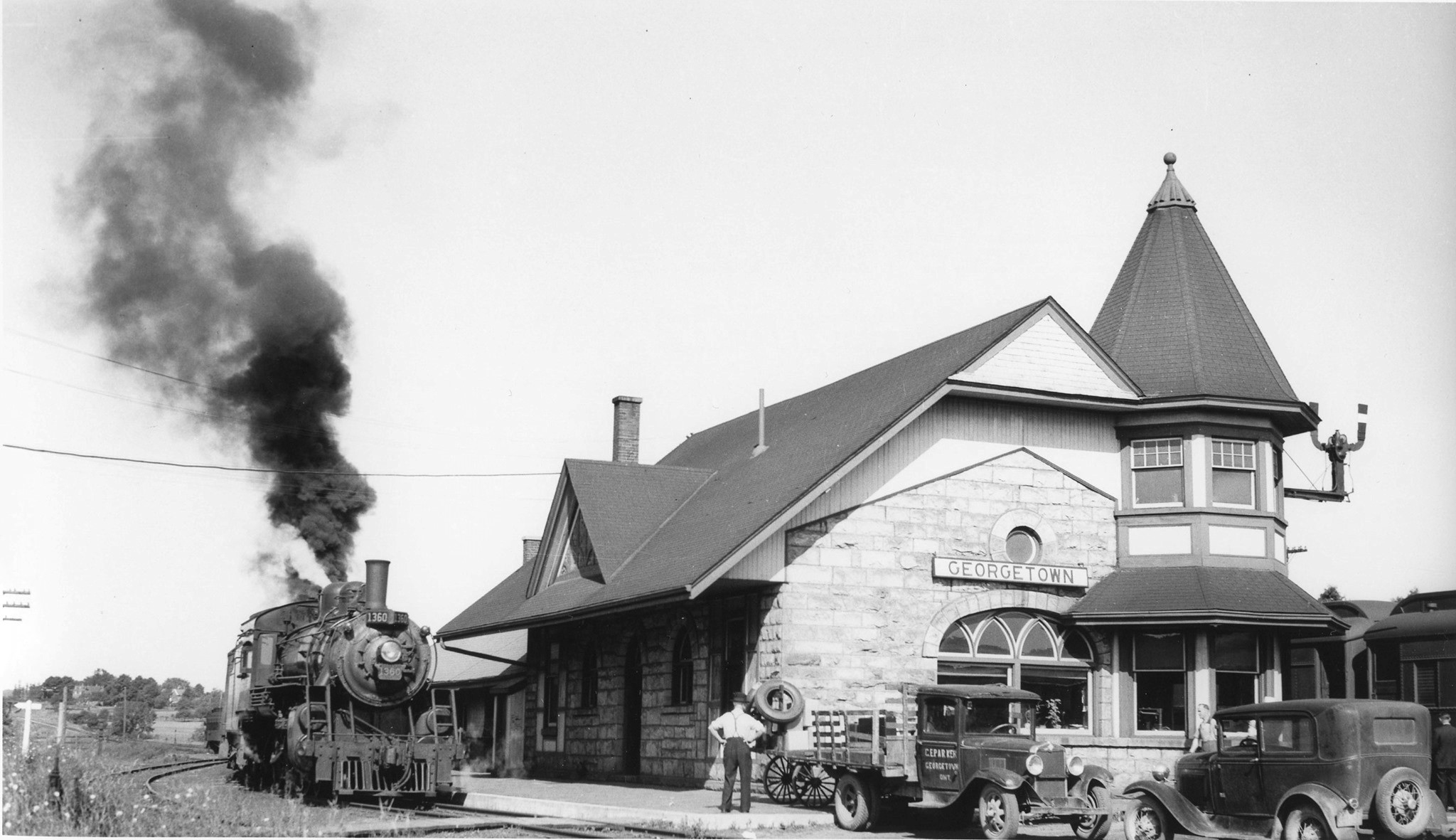Summary
Georgetown Station was built in 1856 by the Grand Trunk Railway while construction was progressing westward towards Sarnia from Toronto. When work on the line began a couple of years prior, it was announced that its stations would not match the elegant limestone features that were used exclusively on the line’s eastern counterpart on the opposite side of Toronto. This plan was changed after the public expressed their distaste towards the decision. A handful of stone stations were built in certain places and the settlement of Georgetown was one of the communities that would receive one. It was a relatively simple rectangular building with a pitched roof and five bays with french doors on the front and back walls of the building. The side walls had a pair of arched windows and four chimneys adorned the roof with one at each corner. The arrival of the railway brought much prosperity to Georgetown in the years following, in 1864 it was incorporated as a village and had a population of about 1,500 people.
The Hamilton & Northwestern Railway passed through Georgetown perpendicular to the Grand Trunk in 1878, close to the present-day intersection of Carruthers Road and Promenade Trail. The H&NW had initially intended to cross the Grand Trunk at grade, but they were met with opposition to the plan. Instead, the H&NW mainline was raised along an embankment from which it would use a bridge to pass over it. Within a year of its opening, the Hamilton & Northwestern merged with its rival the Northern Railway of Canada to form the Northern & North Western Railway. In another nine years, the Grand Trunk would gain control of the N&NW resulting in significant changes to the track alignment in Georgetown. Work was started soon afterward to rearrange the former N&NW in such a way that it would allow trains on that line to stop at the Grand Trunk station without needing to reverse a significant distance. The bridge was removed in 1891 and a new wye junction was created just north of the station in 1892.
As Georgetown was now located at the convergence of two railway lines, the original Grand Trunk station was becoming inadequate for the railway’s needs. In 1904, the structure was heavily renovated with a much higher pitched roof and an ornate turret at the northeast corner of the building. A baggage room extension was also built onto the station’s west side. The bays had their french doors removed over time and some were converted into windows, though still retain the rounded arches above them. The outline of these bays and the stonework surrounding them are some of the only remaining exterior features left after the renovations were complete. A wooden water tower was also built behind the station with underground pipes connecting it to a pair of standpipes at each end of the station platform, allowing steam engines to fill up while stopped for passengers. A year later in December 1905, rail traffic capacity through Georgetown was increased by double-tracking the entire Grand Trunk line between Toronto and Sarnia.
The Grand Trunk encountered financial difficulties through the early 20th century, resulting in its nationalization and subsequent merger into the newly-formed Canadian National in 1923. The increase ownership and use of automobiles would impact passenger ridership significantly in the decades that followed, especially after the end of World War Two. Highway 401 was completed through Milton in 1960, providing residents of Georgetown direct access to many of the same communities the railway already did. However, the focus on car-centric infrastructure during that time also had the effect of suburbanizing Georgetown and turning it into a bedroom community of Toronto, resulting in an increase in the local population. A total of nine trains running along the former Grand Trunk would have stopped at Georgetown in 1966, four of which were long-distance and regional passenger trains. The former H&NW had much fewer trains owing to the fact that it was a secondary branch line that served a predominantly rural area. Passenger service north of Georgetown ended in 1960 and the last freight movement occurred in 1969. After CN applied to abandon the section of the line north of Georgetown to Cheltenham in 1975, the rails were lifted in 1983 except for the Georgetown wye which remained in place until 1992.
By 1974, the only trains that stopped at Georgetown were commuter services which utilized economical self-propelled Budd Rail Diesel Cars. This service was supplanted by GO Transit in April of the same year with the opening of what is now the Kitchener Line. Intercity service to Chicago returned when the International, a train which was jointly operated by VIA Rail and Amtrak, was rerouted through Georgetown in 1990. While this service was discontinued in 2004, Georgetown continues to see a steady flow of trains from both VIA Rail and GO Transit.
Condensed Station Info:
| Location: | Served By: | Current State: | Date Built: | Date Demolished: |
| North end of Queen Street | GTR (1856 – 1923) CNR (1923 – 1974) GO Transit (1974 – Present) VIA Rail (1978 – Present) Amtrak (1990 – 2004) | Preserved, In Use | 1856 | N/A |




